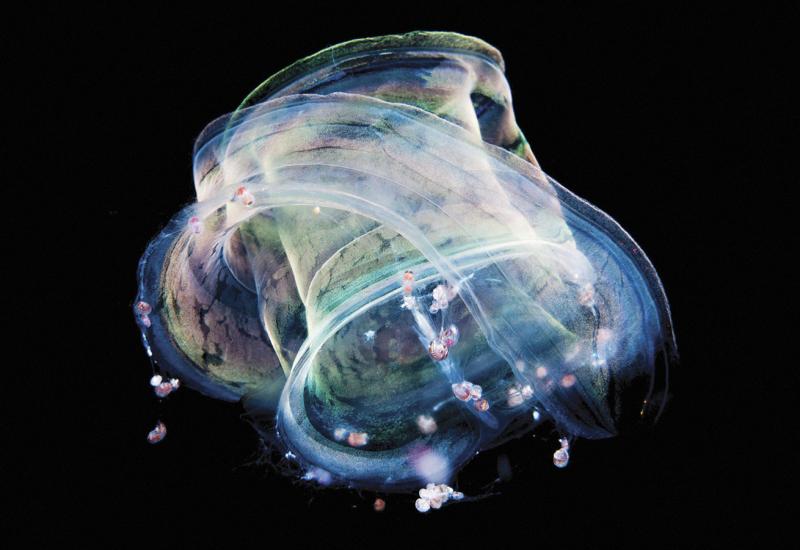What You Need to Know About Deep Diving

Annie CrawleyDivers descend at Roca Partida, Mexico. When deep diving, ensure you and your buddy agree on a plan before entering the water.
here’s nothing like the feeling of rolling off a boat and descending into the abyss, knowing something epic will happen—but not knowing exactly what.
Some of my favorite dives have been below 60 feet. At Darwin’s Arch in Galapagos, there are deep-water king angelfish cleaning stations for hammerhead sharks. When the current is up at Blue Corner in Palau, you kick like mad to get to the point to set your reef hook to see the show of schooling fish and join the party of sharks. Belize’s Blue Hole gives divers a look back in time at gigantic stalactites, a geological phenomenon from when sea level was much lower than today. There’s nothing like dropping in at the Boiler in Socorro to watch the gigantic oceanic mantas say hello—and there’s just something about hovering weightless at 100 feet and being surrounded in every direction by glorious blue, wondering what’s coming next. It gives me a thrill just thinking about it.
With that excitement comes a high level of responsibility. In order to be a safe deep diver, you train to gain a higher level of knowledge and experience.
On liveaboards, almost every dive can be a deep dive. Listen to the dive briefing; there’s often a range of depths described. No matter where you are diving, you should always do your first deep dive with an instructor as part of your advanced or Deep Diver specialty course. After that, choose to seek more experience with a dive professional if you need to get more comfortable deep diving or when changing diving conditions. There’s a big difference between deep diving in cold water and in the tropics. Conditions, location, weather, tides, other divers and the proximity of emergency medical services dictate my personal deep dives and those I do with students or less experienced divers.
Deep diving is any dive past 60 feet/18 meters, with a limit for recreational scuba divers of 130 feet/40 meters. I tend to limit most of my deep diving to 100 feet/30 meters because I choose to use nitrox for deep dives. If there is a wreck or something special below 100 feet, I switch to air.
You need to understand the effects of both nitrogen and oxygen on your body when deep diving. For some, gas narcosis—the euphoric feeling divers can experience from an increased load of nitrogen—sets in at 70 feet. For others, it starts deeper. It gives divers the feeling of the best dive ever. Serious dangers include not monitoring your depth, air or buddy. Knowing deep-diving procedures and your susceptibility to gas narcosis are some of the reasons you dive with an instructor on your first deep dive.
Nitrogen loads in your body tissues on every dive. When you dive deeper, your body absorbs more nitrogen. At 100 feet/30 meters, you are breathing four times as much air as at the surface. Because of this, you need to plan your dives so you do not exceed your no-decompression limits, monitor your air more frequently, and understand the importance of making a safety stop on every deep dive. If diving nitrox, you also track your oxygen. Oxygen becomes toxic at depth, so you want to always keep track of both your nitrogen and oxygen levels.
Know Your Computer
Diving with a computer is standard practice. As a responsible diver, you should download your computer’s app to your mobile, read your computer’s manual fully before using it, and understand the numbers and how to access different menus. On darker deep dives, turn on the light on your computer as if you were night diving. Many computers have a deep-water safety stop. If you blow the deep-water stop, you can get frozen out of your computer for 24 hours. When diving in cold water (or if you get cold in warm water), plan your dive very conservatively and make long safety stops. My computer counts down the three-minute stop, but if conditions allow I extend my safety stop after every dive. Consult with your local dive retailer to decide which computer is right for you. I carry two computers on all my deep dives in case of failure. I also recommend spare batteries in your spare-parts kit and a fully charged computer on every dive.
Deep-Dive Tips
We lose light as we descend. On all deep dives, I carry a primary light and a backup light. Although many dive regions boast crystal-clear waters, I’ve experienced conditions in midday that were more like a night dive. I’m always prepared for dark water on deep dives.

Annie CrawleyBaitballs often move fast—pay attention to your ascent rate.
Never use new equipment on a deep dive—take time to dial it in at your local dive center and on a shallow dive. If you wear a hood, adjust your mask strap. Do a pre-check, review hand signals, and decide what to do in an emergency. Carry a dive slate. Dive with a familiar buddy. Many divers use pony bottles and the skills learned from self-reliant diver training.
The deeper you dive, the more your air spaces compress, including your wetsuit, undergarments and drysuit. Many divers are surprised at how much air is needed for neutral buoyancy at depth. As you descend, remember to check your buoyancy every time you equalize your ears and remember to equalize your mask. Mask squeeze is real, and you don’t want to start your diving holiday with a couple of black eyes. On your safety stop, you often need to deploy a delayed surface marker buoy. Practice builds confidence. Never push your limits, especially when in remote locations. Don’t jeopardize your safety nor that of fellow divers. Deep diving offers unique opportunities, but safety must be a priority on every dive.










